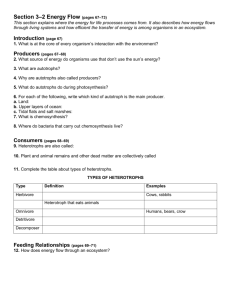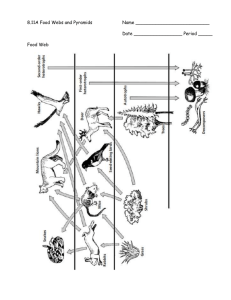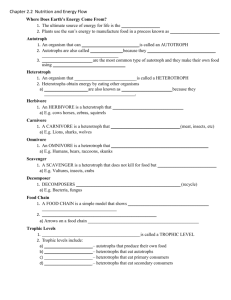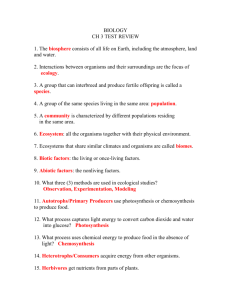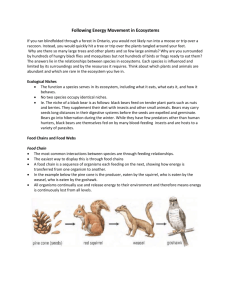Autotrophs
advertisement
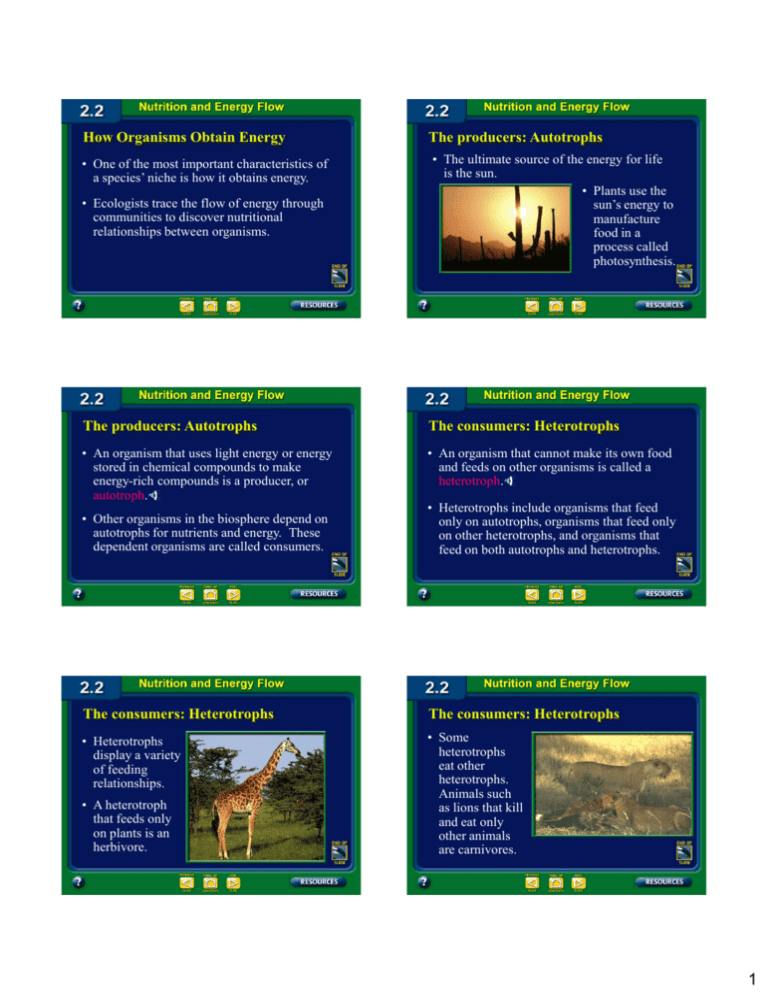
How Organisms Obtain Energy The producers: Autotrophs • One of the most important characteristics of a species’ niche is how it obtains energy. • The ultimate source of the energy for life is the sun. • Plants use the sun’s energy to manufacture food in a process called photosynthesis. • Ecologists trace the flow of energy through communities to discover nutritional relationships between organisms. The producers: Autotrophs The consumers: Heterotrophs • An organism that uses light energy or energy stored in chemical compounds to make energy-rich compounds is a producer, or autotroph. • An organism that cannot make its own food and feeds on other organisms is called a heterotroph. • Other organisms in the biosphere depend on autotrophs for nutrients and energy. These dependent organisms are called consumers. • Heterotrophs include organisms that feed only on autotrophs, organisms that feed only on other heterotrophs, and organisms that feed on both autotrophs and heterotrophs. The consumers: Heterotrophs The consumers: Heterotrophs • Heterotrophs display a variety of feeding relationships. • Some heterotrophs eat other heterotrophs. Animals such as lions that kill and eat only other animals are carnivores. • A heterotroph that feeds only on plants is an herbivore. 1 The consumers: Heterotrophs The consumers: Heterotrophs • Scavengers eat animals that have already died. • Some organisms, such as bacteria and fungi, are decomposers. The consumers: Heterotrophs • Decomposers break down the complex compounds of dead and decaying plants and animals into simpler molecules that can be more easily absorbed. Flow of Matter and Energy in Ecosystems Autotrophs Third-order heterotrophs First-order heterotrophs Second-order heterotrophs Decomposers Food chains: Pathways for matter and energy Food chains: Pathways for matter and energy • A food chain is a simple model that scientists use to show how matter and energy move through an ecosystem. • A food chain is drawn using arrows to indicate the direction in which energy is transferred from one organism to the next. • In a food chain, nutrients and energy move from autotrophs to heterotrophs and, eventually, to decomposers. berries → mice → black bear 2 Food chains: Pathways for matter and energy Trophic levels represent links in the chain • Most food chains consist of two, three, or four transfers. • Each organism in a food chain represents a feeding step, or trophic level, in the passage of energy and materials. • The amount of energy remaining in the final transfer is only a portion of what was available at the first transfer. • A first order heterotroph is an organism that feeds on plants, such as a grasshopper. • A portion of the energy is given off as heat at each transfer. Trophic levels represent links in the chain • A second order heterotroph is an organism that feeds on a first order heterotroph. • A food chain represents only one possible route for the transfer of matter and energy through an ecosystem. Chihuahuan raven Food webs Honey mesquite (pods eaten by beetles) Pronghorn antelope Jackrabbit Long-tail weasel Desert tortoise Prickly pear cactus Roadrunner Kangaroo rat (seed eater) ants Texas horned lizard Red spotted toad • Ecologists interested in energy flow in an ecosystem may set up experiments with as many organisms in the community as they can. • The model they create, called a food web, shows all the possible feeding relationships at each trophic level in a community. Energy and trophic levels: Ecological pyramids • An ecological pyramid can show how energy flows through an ecosystem. Gambel quail Coyote (top carnivore) Food webs Mexican whiptail lizard Mojave rattlesnake • The base of the ecological pyramid represents the autotrophs, or first trophic level. Higher trophic levels are layered on top of one another. 3 Energy and trophic levels: Ecological pyramids Pyramid of Energy • The pyramid of energy illustrates that the amount of available energy decreases at each succeeding trophic level. Heat Heat 0.1% Consumers 1% Consumers 10% Consumers Heat 100% Producers Heat Energy and trophic levels: Ecological pyramids • Some of the energy transferred at each successive trophic level enters the environment as heat, but the total amount of energy remains the same. Energy and trophic levels: Ecological pyramids • Biomass is the total weight of living matter at each trophic level. A pyramid of biomass represents the total weight of living material available at each trophic level. Pyramid of Biomass 1 kilogram of human tissue 10 kilograms of beef 100 kilograms of grain Energy and trophic levels: Ecological pyramids • The total energy transfer from one trophic level to the next is only about ten percent because organisms fail to capture and eat all the food energy available at the trophic level below them. Energy and trophic levels: Ecological pyramids Pyramid of Numbers Fox (1) Birds (25) Grasshoppers (250) Grasses (3000) • A pyramid of numbers shows that population sizes decrease at each higher trophic level. Cycles in Nature • Matter, in the form of nutrients, moves through, or is part of, all organisms at each trophic level. • But matter is cycled and is not replenished like the energy from sunlight. There is a finite amount of matter. 4 The water cycle The carbon cycle • In the water cycle, water is constantly moving between the atmosphere and Earth. • From proteins to sugars, carbon is the building block of the molecules of life. • Linked carbon atoms form the frame for molecules produced by plants and other living things. Condensation Evaporation Transpiration Precipitation Runoff Evaporation • Organisms use these carbon molecules for growth and energy. Oceans Groundwater The carbon cycle Open burning Photosynthesis Respiration The nitrogen cycle Atmospheric CO2 Respiration Fuel Combustion Fuel Combustion Photosynthesis • In the nitrogen cycle, nitrogen is converted from a gas to compounds important for life and back to a gas. Dissolved CO2 Respiration Death and decay Death and decay Fossil fuels The nitrogen cycle The phosphorus cycle Nitrogen in the atmosphere • In the phosphorus cycle, phosphorus moves between the living and nonliving parts of the environment. Some excess nitrogen evaporates from soil. Assimilated by plants Nitrogen-fixing bacteria in the nodules on roots of leguminous plants fix atmospheric nitrogen. Nitrogen-fixing soil bacteria Released to the atmosphere Nitrogen compounds released into soils and acted upon by soil bacteria Dead plant Urine from matter Decomposing animals organisms Decomposers—bacteria and fungi—break down tissues and wastes and nitrogencontaining compounds are released. Converted to other nitrogen compounds by soil bacteria 5 The phosphorus cycle Rain washes phosphates from the land. Plant wastes Animal wastes Phosphate weathers from rock. Short-term Cycle Geologic process of uplifting occurs over millions of years. Decaying materials containing phosphates settle out into streams and oceans. Phosphates become available for plants again. Phosphates released Phosphates into soil,. leach into streams from Soil decomposers act on soil. plant and animal wastes. Phosphate enters streams and oceans from weathering rocks, runoff, and leaching, from soil. Long-term Cycle New rock forms from sedimentation. Phosphate becomes locked in rocks. 6


